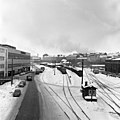
The Helsinki Metro is a rapid transit system serving Greater Helsinki, Finland. It is the world's northernmost metro system. It was opened to the general public on 2 August 1982 after 27 years of planning. It is operated by Helsinki City Transport for HSL and carries 92.6 million passengers per year.

Hakaniemi is an unofficial district of Helsinki, the Finnish capital. It covers most of the neighbourhood of Siltasaari in the district of Kallio. Hakaniemi is located at the sea shore and is separated from the city centre by the Siltavuorensalmi strait and from the district of Linjat by the street Hämeentie. Historically, Hakaniemi was often associated with the working class and workers' associations. However, the cost of living has risen considerably in recent years and is now on par with that of the rest of central Helsinki.

Sörnäinen is a neighbourhood in the city of Helsinki, Finland.
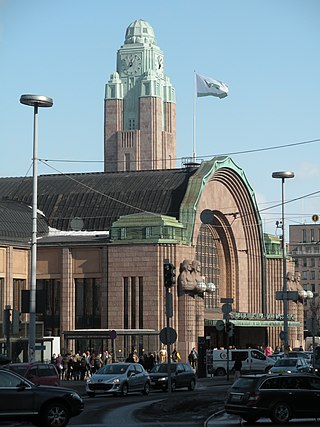
Helsinki Central Station (HEC) is the main station for commuter rail and long-distance trains departing from Helsinki, Finland. The station is used by approximately 400,000 people per day, of whom about 200,000 are passengers. It serves as the terminus for all trains in the Helsinki commuter rail network, as well as for all Helsinki-bound long-distance trains in Finland. The Rautatientori metro station is located in the same building.

Pasila station is a railway station in Helsinki, Finland, approximately 3.5 kilometres (2.2 mi) north of Helsinki Central. It is the second busiest railway station in Finland, after Helsinki Central, and takes up a large part of the district of Pasila. The station was first opened in 1862 along the Finnish Main Line. The current station building opened in 2019.

Pasila is a part of Helsinki, Finland, that is both a central-northern neighbourhood and district, bordering the areas of Alppila to the south, the Central Park (Keskuspuisto) to the west, and Vallila to the east.

Jätkäsaari is a peninsula and a quarter in Helsinki, the capital city of Finland. It is part to the Kampinmalmi district and Länsisatama neighbourhood. It was the location of the main container harbour in Helsinki until late 2008, when the harbour moved to the new facilities in Vuosaari. The terminal for passenger ferries to Tallinn, Estonia, remains in Länsisatama.

Itä-Pasila (Finnish), Östra Böle (Swedish) is a neighborhood of Helsinki, Finland.

Until 2021, Helsinki was Finland's only remaining city with tram traffic. Two other cities—Turku (see Turku tram) and Vyborg —have had tram systems. Vyborg abandoned its trams in 1957 after it was ceded to the Soviet Union after the end of World War II. Turku withdrew its trams in 1972.
The city of Helsinki and the neighbouring city of Vantaa has plans for a radical expansion of the Helsinki tram network within the 2020s and 2030s that would more than double the length of the network from 2021. If completed, the plans would both extend the current tram lines and build new light rail lines.

The Mall of Tripla is a shopping mall in Keski-Pasila, Helsinki, Finland. The mall, along with a rebuilt railway station, opened on 17 October 2019. With a total leasable retail area of 85,394 square metres (919,170 sq ft), the mall is the fourth-largest shopping mall in Finland and in terms of total leasable units, the largest shopping mall in Northern Europe.

Kalasatama is a neighbourhood in the city of Helsinki, Finland. The area is officially part of the Sörnäinen district; and like Sörnäinen, Kalasatama is located a little more than one kilometre north from the coastal centre of Helsinki, near the district of Hakaniemi, and the east side of Kalasatama borders the sea. Itäväylä, which leads in the direction of East Helsinki, runs next to Kalasatama. The Isoisänsilta pedestrian and cycling bridge, opened in 2016, connects Kalasatama to the nearby islands of Mustikkamaa, Korkeasaari and Kulosaari.

Sörnäisten rantatie is a wide street in Sörnäinen, Helsinki, Finland. It leads from the Hakaniemi market square to Suvilahti near the Kalasatama metro station.
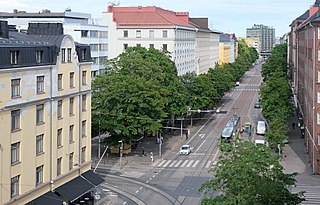
Helsinginkatu is a two-kilometre-long east-west-running street in Helsinki, Finland. The street runs from Hämeentie to Mannerheimintie. The street separates the districts of Kallio and Alppiharju, however the part west to the railway underpass belongs to Taka-Töölö. The eastern part of the street is a 30-metre-wide avenue, with buildings on both sides. Between the avenue part and the railway underpass there are only buildings on the southern side of the street, except for the Helsinki Sports House. To the west of the railway the street runs along the shore of the Töölönlahti bay and the only buildings on it are the Finnish National Opera and Ballet and restaurant Töölönranta. Helsinginkatu is lit with lights hanging from wires and paved with asphalt throughout its length. There is also a tram track running throughout the street.
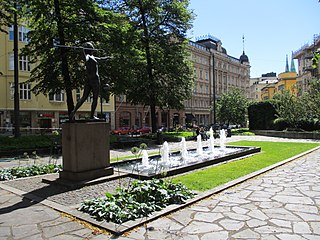
Kolmikulma, also known as the Diana Park, is a small, rectangular triangular-shaped park located in the Kaartinkaupunki district in the city center of Helsinki, Finland. It is limited by the Yrjönkatu, Uudenmaankatu and Erottajankatu streets. The park was renovated in 2006 and 2007.
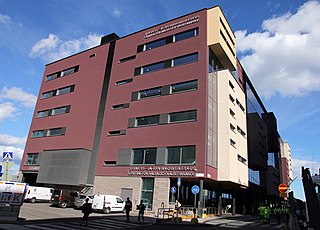
The Kalasatama Health Station is a service centre for health and social services in the Kalasatama neighbourhood of the Sörnäinen district in Helsinki, Finland. It is located about 200 metres to the east-northeast of the Kalasatama metro station.

Sompasaari is an island on the Kruunuvuorenselkä water area in the Sörnäinen district in Helsinki, Finland. On the southern side of the Nihdinkanava channel built in the middle of Sompasaari is the island of Nihti.
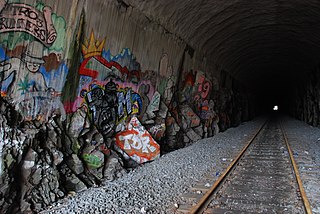
Pasila Rail Tunnel is a former 650-meter railway tunnel under Itä-Pasila residential area in Helsinki, Finland. It used to serve as part of the Sörnäinen harbour rail from 1965 to 2008. The west end of the tunnel located near Pasila railway station and ended up in Vallila in the east.
Nihti is an island on the Kruunuvuorenselkä water area in the Sörnäinen district in Helsinki, Finland. On the northern side of the Nihdinkanava channel is the island of Sompasaari.

Sörnäinen Harbour was for nearly one and a half centuries a major harbour and freight terminal in the Port of Helsinki, located in the Sörnäinen district on the eastern shore of the Helsinki city centre area.






